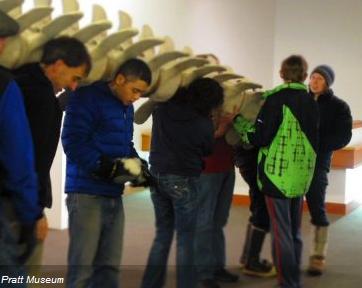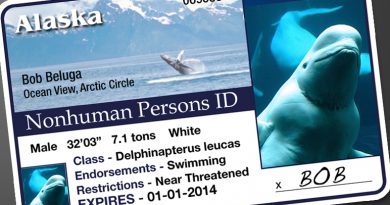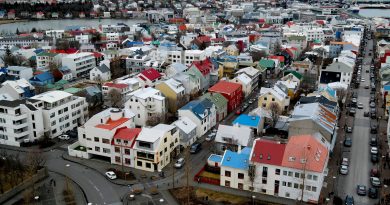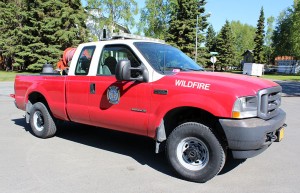Homer, Alaska museum nears completion of 1,800-pound gray whale skeleton
 After 14 years and with the help of hundreds of volunteers, the Pratt Museum in Homer, Alaska, will soon be home to a Pacific gray whale skeleton, the centerpiece of an upcoming exhibition set to open for the public next month.
After 14 years and with the help of hundreds of volunteers, the Pratt Museum in Homer, Alaska, will soon be home to a Pacific gray whale skeleton, the centerpiece of an upcoming exhibition set to open for the public next month.
The museum landed its whale way back in 1999, after it was observed in Kachemak Bay, behaving strangely. The whale, a male juvenile, died shortly thereafter and washed ashore, according to Scott Bartlett, the Pratt Museum’s curator of exhibitions.
He wasn’t alone. No one is sure why hundreds of gray whales beached between 1999-2000 but a huge spike in Pacific gray fatalities followed. In 1999 alone, 283 grays died between Mexico and Cook Inlet off the Southcentral Alaska coast, compared to an average annual mortality rate of about 41. By 2001, gray whale deaths had normalized to 21. But the mystery remains unsolved.
With a dead whale on the beach, the community organized to act. After the state released possession of the whale, efforts to preserve the whale’s skeleton began, with 50 volunteers for the butchering. Next, the whale’s bones were sunk in crab pots and anchored in Kachemak Bay’s deep waters, where they sat for nine months as sea creatures slowly ate away all organic material. Once the bones were pulled up from the sea, they sat outside for a winter, and were then taken to a local car wash for cleaning before being catalogued.
Everything except the flippers, that is. Those were buried in horse manure for three years – until 2002 – to help break down the heavy cartilage around the carpals. Burying the whale’s flippers kept intricate bone structure intact. They were then dug up and photographed, a guide for skeleton reconstruction to come.
In 2004, all the bones were pulled from storage, photographed, consolidated and treated. After that, they were returned to storage, where they lay undisturbed until summer 2012, when the skeleton once again brought the community together in what Bartlett called an overwhelming show of public support.
Second life for gray whale with help from ‘Boneman’
Homer is the last stop on the Sterling Highway, about five hours south of Alaska’s largest city. Bumper stickers boast of hard fishing and hard drinking. But it’s also attracted an array of artists and writers and engineers and naturalists.
Count Lee Post, known to locals as “the Boneman,” among them. Post is Homer’s local bone expert. He’s lived here since the 1970s and has authored 10 books on the articulation of skeletons of creatures great and small, from birds to belugas. The museum houses many specimens Post has reconstructed — a beluga whale, a harbor porpoise, a sea turtle and harbor seal — over some four decades, according to Bartlett.
Last summer, Post organized a volunteer force to begin moving the mammoth gray whale skeleton over to the Pratt Museum. When it’s completed, this 38-foot, 1,800-pound whale skeleton will count as one of Post’s crowning achievements, larger in scope and scale than any other specimen he’s helped piece back together, save one: the 41-foot sperm whale pieced together by local students and now on display at Homer High School.
They have been constructing the skeleton in the museum’s workshop, which isn’t large enough to hold the entire specimen. So, volunteers have pieced together parts of the whale – it’s 8 foot tail, 600 pound spinal column, and 550 pound skull – and have begun moving it into the gallery, piece by piece.
Putting together the entire skeleton is going to take a lot of man power.
“It’ll be a production,” Bartlett said.
Still, for all the work that has gone into hauling the whale into the museum, it’s a “temporary thing,” Bartlett laughs. It’s the sneak preview of a permanent exhibit that will go on display at the new Pratt Museum that is scheduled to begin construction next year, and will hopefully be complete by 2016.
The exhibit “Encounters: Whales in our Waters” will explore the relationship between humans and whales, and will feature whale research concerning a variety of whale species that come into Kachemak Bay and the Lower Cook Inlet. The exhibit will include interactive displays and research on whale acoustics.
It’s about more than the gray whale, Barlett explains. But he’s “the star of the show.”
Contact Laurel Andrews at laurel(at)alaskadispatch.com
For more stories from Alaska Dispatch, click here



